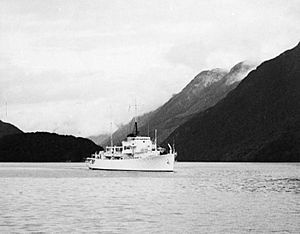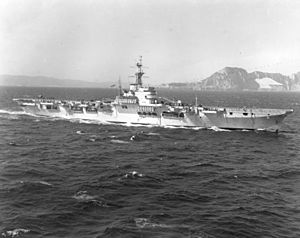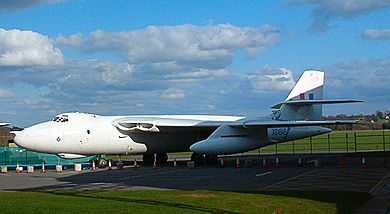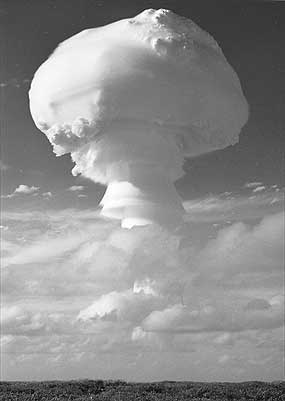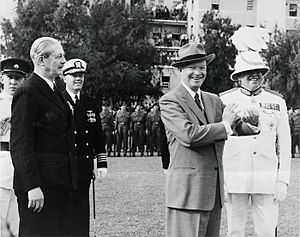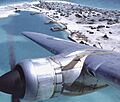Operation Grapple facts for kids
Quick facts for kids Grapple |
|
|---|---|
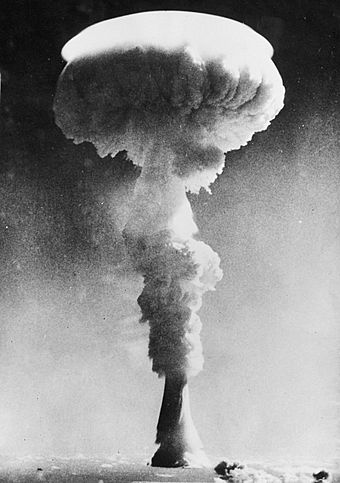
The Grapple 1 test in May 1957. It was called Britain's first hydrogen bomb test, but it didn't work as planned.
|
|
| Information | |
| Country | United Kingdom |
| Test site |
|
| Period | 1957–1958 |
| Number of tests | 9 |
| Test type | Air drop, balloon |
| Max. yield | 3 megatonnes of TNT (12.6 PJ) |
| Navigation | |
| Previous test series | Operation Antler |
| Next test series | NTS series |
Operation Grapple was a series of British nuclear weapons tests that happened in 1957 and 1958. These tests involved early atomic bombs and powerful hydrogen bombs. They took place on Malden Island and Kiritimati (also known as Christmas Island) in the Pacific Ocean. These islands are now part of Kiribati.
The goal of Operation Grapple was for Britain to develop its own hydrogen bomb. After nine nuclear explosions, the United Kingdom became the third country to have these powerful weapons. This also helped to improve the special friendship and nuclear sharing between Britain and the United States, leading to the 1958 US–UK Mutual Defence Agreement.
Contents
Why Britain Needed the Bomb
A Secret Wartime Project
During World War II, Britain had a secret project called Tube Alloys to build nuclear weapons. In 1943, this project joined forces with the American Manhattan Project. Many top British scientists helped the Americans build the first atomic bombs.
After the War
After the war, Britain worried about losing its place as a powerful country. So, the government started its own atomic bomb project again, called High Explosive Research. In 1952, Britain successfully tested an atomic bomb in Operation Hurricane. This was a huge scientific achievement.
However, the United States had already developed even more powerful thermonuclear weapons, also known as hydrogen bombs. Britain was several years behind. In 1954, the British government decided that to remain a "great power," it also needed to develop hydrogen bombs.
Designing the Bombs
Scientists at the Atomic Weapons Research Establishment in Aldermaston worked on three main designs. These included a large fission weapon called Orange Herald and two types of hydrogen bombs: Green Bamboo and Green Granite. A hydrogen bomb works in two main steps. First, a small atomic bomb (called the "Tom") explodes. This explosion then triggers a much bigger fusion reaction in the second part (called the "Dick").
These new bomb designs had to be tested to make sure they worked. This is why Operation Grapple was planned.
Choosing a Test Site
Finding a Safe Place
Testing nuclear bombs is very dangerous. After a Japanese fishing boat was accidentally exposed to radioactive fallout from an American test, it became clear that a very remote test site was needed. Scientists looked at many islands in the South Pacific and Southern Oceans.
Malden and Christmas Islands
Eventually, Malden Island was chosen for the air-dropped tests. It was an uninhabited island claimed by both Britain and the United States. Kiritimati (Christmas Island) was chosen as the main base for the operation. It was also claimed by both countries and was very far from other places.
Christmas Island was a tropical island with grass and coconut trees. About 260 local people, called Gilbertese, lived there and worked on coconut farms. For their safety, many of them were moved to a nearby island during the tests.
Getting Ready for the Tests
Setting Up the Operation
The secret name for the test series was Operation Grapple. Air Vice Marshal Wilfrid Oulton was put in charge of the whole operation. Many different parts of the British military were involved, including the Royal Air Force (RAF) with its Vickers Valiant bombers and English Electric Canberra planes.
Building the Base
The Royal Engineers and RAF worked hard to get Christmas Island ready. They improved the airfield so large planes could land and take off. They also made the port better and built new facilities. This included roads, power, water, and storage. The island's population grew to 3,000 people during this time.
Many ships were used to bring supplies and people. HMS Warrior, a light aircraft carrier, was the main control ship. HMS Messina, a large landing ship, became the headquarters ship.
The United States military also gave a lot of help. RAF planes could fly over the US, and ground crews stayed at US air bases. This cooperation was very important for the operation.
The Tests Begin
First Series: Grapple 1, 2, and 3
The first series of tests had three explosions. All the bombs were dropped from planes over Malden Island. They were set to explode high in the air to reduce nuclear fallout, which is dangerous radioactive dust.
- Grapple 1 (May 1957): The first bomb, called Short Granite, was dropped. Its explosion was much smaller than planned, about 300 kilotonnes of TNT (1,300 TJ). Even though it didn't work perfectly, the government said it was a successful hydrogen bomb test.
- Grapple 2 (May 1957): This test used Orange Herald. It was a very large fission bomb, not a true hydrogen bomb. Its yield was about 720 to 800 kilotonnes of TNT (3,000 to 3,300 TJ), making it the biggest single-stage nuclear device ever exploded. Britain kept this secret for many years.
- Grapple 3 (June 1957): This test was another try with a fixed Short Granite bomb, called Purple Granite. Its yield was only 200 kilotonnes of TNT (840 TJ), which was very disappointing. Scientists knew they had to try again.
Grapple X: The First True H-Bomb
A second test, called Grapple X, happened in November 1957. To save money, this bomb was dropped near Christmas Island, only 20 nautical miles (37 km; 23 mi) from the airfield. This meant building new shelters and facilities on Christmas Island.
The bomb, called Round A, was dropped by a Valiant bomber. Its explosion was about 1.8 megatonnes of TNT (7.5 PJ), which was even bigger than expected! This was the first real hydrogen bomb that Britain had successfully tested. The large explosion caused some damage to buildings and helicopters on the island.
Grapple Y: The Biggest Test
Scientists at Aldermaston kept working to improve their designs. They came up with a new bomb called "Dickens." The test for this bomb, called Grapple Y, happened in April 1958.
This bomb had an explosive yield of about 3 megatonnes of TNT (13 PJ). It remains the largest British nuclear weapon ever tested. This test was very successful because most of its power came from the fusion reaction, making it a true hydrogen bomb. Also, its yield was very close to what the designers predicted, showing they understood how to build it.
Grapple Z: Final Tests
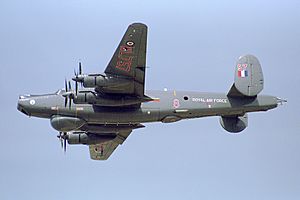
In August 1958, the US President announced a one-year break from nuclear testing, starting in October. This made Britain and the Soviet Union rush to do as many tests as possible before the deadline.
The final series, Grapple Z, had four tests. These tests explored new ways to make bombs smaller and lighter. They also looked at how to make bombs immune to damage from other nearby nuclear explosions.
- Pendant (August 1958): This bomb was lifted into the air by four large balloons instead of being dropped from a plane. It had a yield of about 24 kilotonnes of TNT (100 TJ).
- Flagpole (September 1958): This bomb was dropped by a Valiant bomber using radar, not by sight. It exploded with a yield of about 1.2 megatonnes of TNT (5.0 PJ).
- Halliard (September 1958): This was an unusual three-stage bomb design. It was also dropped by a Valiant and had a yield of about 800 kilotonnes of TNT (3,300 TJ).
- Burgee (September 1958): The final test was another balloon-borne bomb. It had a yield of about 25 kilotonnes of TNT (100 TJ).
These tests helped British scientists learn everything they needed to build powerful, modern hydrogen bombs. The international break in testing began on October 31, 1958, and Britain never tested nuclear weapons in the atmosphere again.
Summary of Tests
| Name | Date time (UTC) | Location | Height | Delivery | Device | Yield | Notes | References |
|---|---|---|---|---|---|---|---|---|
| Grapple 1 | 15 May 1957 19:37 | Malden Island, Kiribati 4°03′S 154°54′W / 4.05°S 154.9°W |
2,200 m (7,200 ft) | air drop | Short Granite | 300 kilotonnes of TNT (1,260 TJ) | An attempted hydrogen bomb test, but the explosion was smaller than planned. | |
| Grapple 2 | 31 May 1957 19:41 | Malden Island, Kiribati 4°03′S 154°54′W / 4.05°S 154.9°W |
2,400 m (7,900 ft) | air drop | Orange Herald | 720 kilotonnes of TNT (3,010 TJ) | A very large fission bomb. | |
| Grapple 3 | 19 June 1957 19:40 | Malden Island, Kiribati 4°03′S 154°54′W / 4.05°S 154.9°W |
2,400 m (7,900 ft) | air drop | Purple Granite | 200 kilotonnes of TNT (837 TJ) | Another attempt to fix the Short Granite bomb, but it was still unsuccessful. | |
| Grapple X | 8 November 1957 17:47 | Kiritimati (Christmas Island), Kiribati 1°40′43″N 157°13′59″W / 1.67851°N 157.23303°W |
2,250 m (7,380 ft) | air drop | Round A | 1.8 megatonnes of TNT (7.53 PJ) | Britain's first successful hydrogen bomb. | |
| Grapple Y | 28 April 1958 19:05 | Kiritimati (Christmas Island), Kiribati 1°40′15″N 157°14′14″W / 1.6709°N 157.23726°W |
2,350 m (7,710 ft) | air drop | Dickens | 3 megatonnes of TNT (12.6 PJ) | The largest explosion from a British nuclear device. | |
| Grapple Z1 | 22 August 1958 18:00 | Kiritimati (Christmas Island), Kiribati 1°43′46″N 157°12′38″W / 1.72934°N 157.21065°W |
450 m (1,480 ft) | balloon | Pennant | 24 kilotonnes of TNT (100 TJ) | ||
| Grapple Z2 | 2 September 1958 17:24 | Kiritimati (Christmas Island), Kiribati 1°40′10″N 157°13′39″W / 1.66932°N 157.22742°W |
2,850 m (9,350 ft) | air drop | Flagpole | 1 megatonne of TNT (4.18 PJ) | ||
| Grapple Z3 | 11 September 1958 17:49 | Kiritimati (Christmas Island), Kiribati 1°39′09″N 157°13′25″W / 1.65248°N 157.22374°W |
2,650 m (8,690 ft) | air drop | Halliard | 800 kilotonnes of TNT (3,350 TJ) | ||
| Grapple Z4 | 23 September 1958 18:00 | Kiritimati (Christmas Island), Kiribati 1°45′07″N 157°11′17″W / 1.75194°N 157.18819°W |
450 m (1,480 ft) | balloon | Burgee | 25 kilotonnes of TNT (105 TJ) |
What Happened Next
Working with the United States
After the Soviet Union launched the first satellite, Sputnik 1, in October 1957, the United States was shocked. This made them more willing to work with Britain again. British Prime Minister Harold Macmillan suggested that the two countries share their knowledge.
Because Britain had successfully developed its own hydrogen bomb, the US government changed its laws. This allowed them to share nuclear technology with Britain again. In 1958, they signed the 1958 US–UK Mutual Defence Agreement. Macmillan called this "the Great Prize."
This special relationship helped Britain a lot. Britain started using American bomb designs, like the Mark 28, which became known as Red Snow. Britain also received nuclear materials from the US. Later, the British Navy even used American missiles with British nuclear warheads.
Other Tests and Independence
The United States also used Christmas Island for its own nuclear tests in 1962, called Operation Dominic. Twenty-four nuclear bombs were exploded near the island during this time.
In 1979, the islands, including Christmas Island and Malden Island, became the independent country of Kiribati. The spelling of Christmas Island's name was changed to Kiritimati, which is how it's written in the local Gilbertese language.
Health Concerns
Over the years, there have been concerns about the health effects on the servicemen who were part of Operation Grapple. Some studies have looked at the health of these veterans. One study found that some veterans had a higher rate of certain changes in their blood cells.
The UK Ministry of Defence has stated that few people were exposed to much radiation. They also say that studies have shown little or no health effects. However, some veterans believe that their illnesses, and even health problems in their children, are a result of being exposed to radiation during the tests.
Many veterans have tried to sue the Ministry of Defence for damages. In 2012, the Supreme Court did not allow a group of British ex-servicemen to sue. However, in 2015, the Prime Minister of Fiji announced that the Fijian government would give compensation to the Fijian servicemen who took part in Operation Grapple. In 2022, British nuclear test veterans were awarded a medal after many years of campaigning.
Images for kids
-
Grapple 1 test in May 1957. Hailed as Britain's first hydrogen bomb test, it was in fact a failure.
-
The destroyer HMS Cossack


